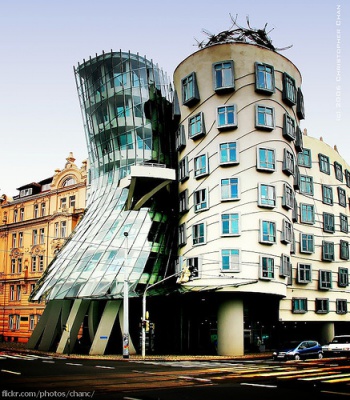 Dancing House by Christopher Chan
Dancing House by Christopher Chan
Prague presents one of the most cosmopolitan cities in Central Europe. Beside galleries or museums, it offers also some modern and sophisticated spectacular buildings. The most famous one is called Dancing House.
The Dancing House is one of the most interesting Prague houses built at the end of the 20th century. It represents a man and a woman (Ginger Rogers and Fred Astaire), dancing together. It was regarded as very controversial several years ago, finally became one of the most acclaimed modern buildings in Prague and awarded the Design of the year 1996 award from the Time Magazine.
Visitors can see this extraordinary house at the corner of Jirasek Square and Rasin Quay alongside the river Vltava. There used to stand a Neo-renaissance house before, but it was demolished by an air raid in 1945, leaving the lot for decades. Vaclav Havel, former president of the Czech Republic, living in neighbourhood, ordered an architectural study of the place from Croatian architect Vlado Milunic. Finally, the Dutch company Nationale Nederlanden bought the place in 1992 and decided to build an administrative centre there. Nationale Nederlanden (now ING) asked Vlado Milunic to partner with another renowned architect. The first choice was French architect Jean Nouvel, but he declined since he thought the surface of the plot was too small for two architects. However Canadian born architect Frank Owen Gehry (famous for Walt Disney Concert Hall, Hotel Marqués de Riscal and Guggenheim Museum) was willing to cooperate after he saw some of Milunic’s sketches of the building.
The building portrays two people dancing hence the original name of the edifice – Fred and Ginger after the famous dance couple Fred Astaire and Ginger Rogers. The building became soon known as the “Dancing House”. Milunic describes the building as a dance performed after the Velvet Revolution.
The construction of the building in what is described as a deconstructionist style – the architects themselves consider the style "new baroque". The modern building starkly contrasts with its surroundings, both in architecture and in use of materials. Construction consists from 99 concrete panels, each of different shape and dimension, each therefore requiring a unique wooden form. PIt features a glass tower which bends and clings at a 45 degree angle to a standard concrete tower, topped by a large metal "cupola", which is said to represent the head of Fred Estaire. Unsurprisingly, when first completed it caused quite a stir amongst locals and has only recently become an architectural icon, despite being finished in 1996.
Critics of the building pointed out that it does not fit into its surroundings, where various Art Noveau houses can be seen. Also the unusual shape of the building was seen as disputable. But after several years, it is regarded as one of the most interesting Prague buildings from the end of the previous century. The interior of the Dancing House was partly designed by the London architect of Czech origin Eva Jiricna. There are mostly offices in the nine-storey house, and there is a French restaurant with a beautiful view over Prague at the top.
Many Prague weekend break city tours call in at the Dancing House for a quick photo opportunity. This Dancing House is the valuable contrast for historical Prague. Spectacular beauty of building presents the architectural heritage for residents and of course visitors.
